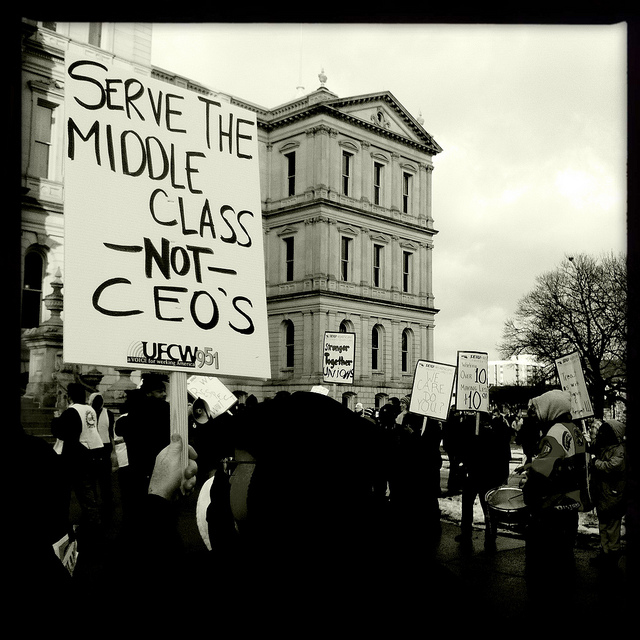In the U.S., the “M” word has been on the lips of politicians from the left to the right of the political spectrum, albeit for different reasons. President Obama is not an exception. Indeed, he made the mention of the middle-class part of his electoral rhetoric immediately after the 2008 financial crisis and after hundreds of thousands of Americans lost their houses, their American dream.
Last February, in his State of the Union address, Obama declared it was “our generation’s task” to “reignite the true engine of America’s economic growth — a rising, thriving middle class.” A few days ago, on August 5, he spoke in a gathering and he again pondered the same message, to “secure a better bargain for the middle class.” Whether we agree with Obama’s plan to revive the middle class or not, one must admit that he has been quite explicit about it. It includes measures affecting child care, dependent care, college expenses and retirement savings.
Here in Canada, Justin Trudeau is on the footsteps of Mr. Obama and his talk is all about the middle class. The only difference is that we don’t have any idea how Justin Trudeau is going to tackle the middle-class issue. Is he going to continue to give free rides to corporations as both Liberal and Conservative governments did in the past, or will he be offering a real program with fiscal and economic measures specifically targeted to the fading middle class? (Even though a lot of words are being said about the new Liberal star candidate in Toronto Centre and how her book might make up the next platform for the Liberal Party campaign). Or is he only interested in the votes of this class and then will turn his back and continue to help the big corporations instead?
But in reality, do we still have a “real” middle class? Where does the political opportunism start and where does the economic reality end?
In the last two decades, generations of politicians watched the erosion and the crushing of the middle class. Some denounced the situation and stood by their principles but many nodded and acquiesced to all the economic and social measures making the poor poorer and the rich richer, effectively shrinking the middle class.
According to a report prepared by Canadian bureaucrats and presented to Finance Minister Jim Flaherty, and recently released by Postmedia, Canada’s middle class improved its average income only by seven per cent between 1976 and 2010. This is equivalent to 0.2 per cent per year. The median income of this class did not do better. From 2007 to 2011, it grew from $66,700 to $68,000, a mere 0.5 per cent per year.
This assessment is confirmed by another report that was prepared by TD Bank. The report documents the fact that low-wage and middle-wage jobs in Canada have been shrinking as a share of the economy as job growth focuses more and more on high-skilled, high-end jobs. Meanwhile, the spending by the middle class didn’t decrease. To the contrary, it continued to increase and the funding comes from the larger amount of debt Canadian families are contracting from the banks and other financial institutions, making the Canadian household one of the most indebted in the OECD countries with a debt-ratio of around 161 per cent for the first quarter of 2013.
Mark Carney, the former governor of the Bank of Canada, never missed an opportunity to speak against the high amount of debt that is contracted by Canadians. The government never raised an eyebrow (until they changed the rules for mortgages). They barely reacted to the horrifying numbers of children who now live in poverty. Canada’s child poverty rate increased between the mid-1990s and the late 2000s. These are not only children born to single parents of low-income families but also to working parents who can’t make enough annual earnings to afford all the basic necessities for their families. The Conference Board of Canada reported that Canada scores a “C” grade and ranks 15th out of 17 peer countries. Moreover, more than one in seven Canadian children live in poverty.
Last July, the city of Detroit in the U.S., where the middle class was first formed by the autoworkers and later by public employers running city services, went bankrupt. The fall of the auto industry, the cuts to public funds, the fiscal structure of the American government and many other socio-economic factors took Detroit to the cliff; it was forced close shop. It is interesting nowadays to watch the Conservative government trying so hard to dismantle the unions in Canada and to slash thousands of jobs in the public sector. Yes, it would be both stretched out and simplistic to draw similarities between Detroit and the path Canada is following. Nevertheless, it is crucial to study the effects of recent public sector cuts and their impacts on the Canadian middle class, and the state of our economy in general.
The middle class today is like a beautiful woman, desired and solicited by everyone but insidiously feared and despised by all. The politicians are no exception.
Monia Mazigh was born and raised in Tunisia and immigrated to Canada in 1991. Mazigh was catapulted onto the public stage in 2002 when her husband, Maher Arar, was deported to Syria where he was tortured and held without charge for over a year. She campaigned tirelessly for his release. Mazigh holds a PhD in finance from McGill University. In 2008, she published a memoir, Hope and Despair, about her pursuit of justice, and in 2011, a novel in French, Miroirs et mirages.
Photo: Peter Klein/flickr



